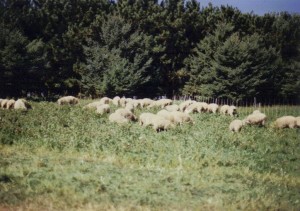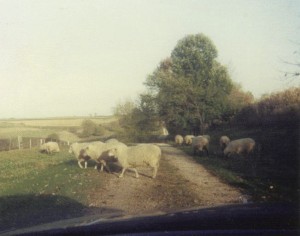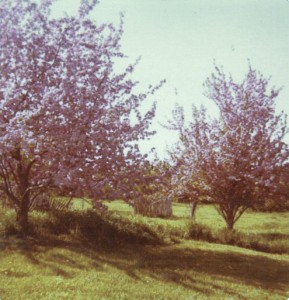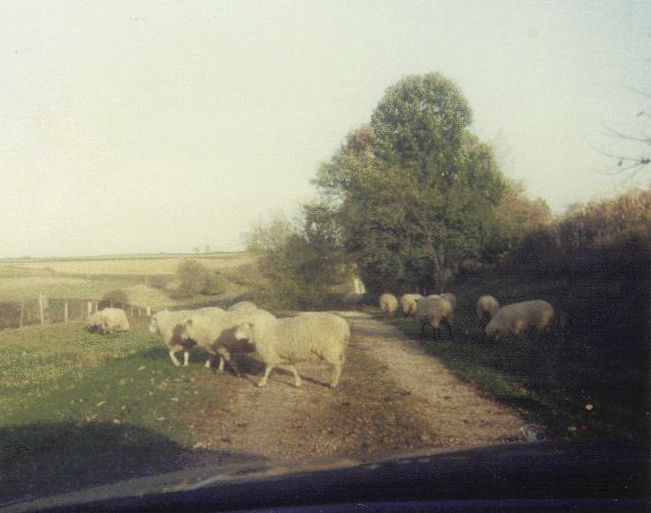January, 1981
Once the Holiday Season was over, the year was off to a roaring start! I missed my errand running girl, who was off to college at Winona State University, immersed in studies and Concert and Jazz Bands. Sean, in 5th grade, was in Cub Scouts, Stamp Club, and starting in Band, which entailed after school lessons three days a week and meant a lot of extra trips to town for me.

Of course I was up to my ears in SEMSPA matters, as usual. We now had 115 member families, and still growing. My locker lamb business continued to grow also, was quite profitable, and I had no trouble selling all the tanned lamb pelts which resulted from it. I was getting a lot of letters from people wanting to know more about the process of recovering, cleaning and drying the pelts, plus information on packing and shipping to the tannery.
Rather than try to answer all the individual requests for information, I put together a sheet of step-by-step instructions which was included in the next “Flock Talk,” SEMSPA’s newsletter, and that saved me from a lot of letter answering.
March 20, the lambing season began… not an auspicious beginning! The first ewe to come in had a vaginal prolapse and I made the mistake of calling a vet. He replaced the prolapse and put in sutures to prevent it reoccurring. In the middle of the night, I went to the barn to check on the ewe, she was up and eating hay… all seemed well. Early next morning, she was dead and had a dead lamb, which she could not deliver.
This unhappy incident taught me to not rely on a vet, but to replace the prolapse and insert a plastic T- shaped prolapse retainer, using a harness to secure it in place. With this method the ewe can successfully lamb through it without assistance..
The fourth ewe to lamb, was Snowflake, an eight year old; she delivered a nice set of twin ewes, but had mastitis in half her udder and would only be able to feed one lamb. I thought that maybe I could graft one of her twins onto the next ewe that singled, if one happened to lamb rather quickly.
Sure enough, another ewe lambed very soon and had a single ram lamb. I thought, “Here’s my chance!” then, “Oh no… not Gidget!” (She was one of my more flighty ewes.) But, I decided to have a go at it anyway, and took one of Snowflake’s lambs and rubbed it with amniotic fluid from Gidget’s water bag, while she was busy cleaning her lamb, inserted my hand a short way into her vulva, to hopefully make her think she was having another lamb, and then presented Snowflake’s lamb under her nose.

Was I surprised when she accepted it immediately! It is not usually that easy! Soon the little “adoptee” got to nurse, and with a tummy full of nice warm colostrum, settled down for a nap beside her new brother. I was a little concerned that Gidget might change her mind while the lambs slept and reject the ewe lamb when it came back to nurse, but she did not. A happy ending!
Lambing continued to go quite well, with few problems. Of 82 lambs born, only 2 were born dead, and of the 80 survivors, 39 were ewe lambs, so our ewe flock would be expanding again!
I had ordered more rolls of “Electronet” portable electric fencing for the upcoming pasture season. It was a lightweight plastic and wire netting, interspersed with fiberglass posts, and came in 150′ lengths to a roll.
I could easily carry two rolls, which would allow me to cross fence my large front pasture, and divide it into small paddocks. The purpose of this being to give the sheep just enough pasture for them to graze in one day.
Each day the back fence of the paddock was taken up and moved to form the front fence of the new paddock, and what had been the front fence the previous day, now became the back fence. There was a lane running along one side of the pasture which allowed access to the paddocks, and the sheep could return to a small area at the front end of the lane where a water tank was located and where there was a large white oak tree for shade.
The sheep thrived under this arrangement, and so did the pastures! We had inter-seeded the native grass pasture with birdsfoot trefoil, and a small amount of red clover seed, and it was becoming more productive each year. Birdsfoot trefoil is a legume, like alfalfa… but, unlike alfalfa, it is non-bloating, which is a great advantage when you depend on grazing. It is somewhat finer-leaved than alfalfa, and is very palatable for sheep. Legumes like alfalfa and trefoil need to be treated with an inoculant specific to that type of seed before seeding to new ground. Once they have been grown on soils it is not necessary to inoculate in the future as the nitrogen fixing bacteria will already be present.
Mid-June, 1981

With the addition of two tart cherry trees, our fruit orchard became even more bountiful. They produced huge crops of cherries, which we relished in pies, jams, etc., and the excess went into the freezer for future enjoyment. The birds, of course, relished the cherries too, and it was a challenge to keep them from consuming all the fruit as fast as it ripened.
We had tried various ploys such as draping cheese cloth or other lightweight material over the top of the trees, but it was not very effective as the slightest breeze could displace the cloth. Finally, I found the solution in one of the seed catalogs, in the form of an inflatable plastic snake, which was very realistic. It had ties attached so it could be fastened to the branches near the top of the tree, and the birds would not come near it. One tree provided us with plenty of cherries, so the second tree, a short distance away, became a “sacrifice” tree for the birds, and thenceforth everyone was happy!
My sister, Merle, also had a cherry tree, but was losing most of the fruit to the birds every year. I got her a fake snake, and all was well… that is, until the hired hand who helped with the barn chores, and who loved to shoot English Sparrows, came dashing into the house to inform her that he had just shot a huge snake in the cherry tree!


Wow, what a busy time for you- yet you seem to have managed it all so effeciently. You were the pioneer for SEMSPA and probabally helped a good many sheep farmers do it easier and hopefully make a small profit.
It is a good thing that you were able to think on your feet so quickly with all the different situations you encountered. I would have never thought of rubbing the amnio fluid on the baby and giving it to another mom to make her think it was her lamb- I am surprised the real momma did not try to take her baby back. When you have a flock of lambs, do they mother collectively all the babies or does each momma only take care of her own?
The snake part really made me smile- how creative and I bet the farm hand felt a bit sheepish afterwards! Glad to have your stories back!
Sands,
Yes, lambing is a very intensive time, and you have to be creative, and on your toes, or you are sunk! Those sheep can think of more ways to confound you than you would imagine… but it’s not done out of malice. No, sheep definitely do not mother the lambs collectively. Each ewe takes care of her own, unless you can trick her, as in the last story, and if a lamb should mistakenly try to nurse from the wrong ewe, it will soon learn the error of its ways in no uncertain terms.
After lambing a ewe and her lamb, or lambs, are put in a small pen in a part of the barn reserved for lambing pens for a couple days, to bond without interference from other sheep. I also kept the ones that had lambed separate from the ones who still had to lamb, less confusion that way for everyone. Once they are done lambing and out on pasture, they all get along fine, and every lamb knows its mothers voice.
It’s good to be back writing, although it was also great to have some time to garden again, even though it has been a battle to raise veggies with no rain for over a month. I had to water a couple times a day to keep then going, and since we pasture cattle, and I was getting my water from the same spigot they were, at times I could only get a trickle. Thankfully, we had a very nice rain yesterday, and it cooled off… temporarily, at least.
Hope everything is well with you, and that your CSA is doing well, but I think you’ve had quite a bit more rain than we have. I have been eating very well out of the garden, lots of salads! I planted my beets too thickly, and am thinning them and using the tops in salads, very good and extremely high in potassium, calcium, and loads of vitamin A.
Lea